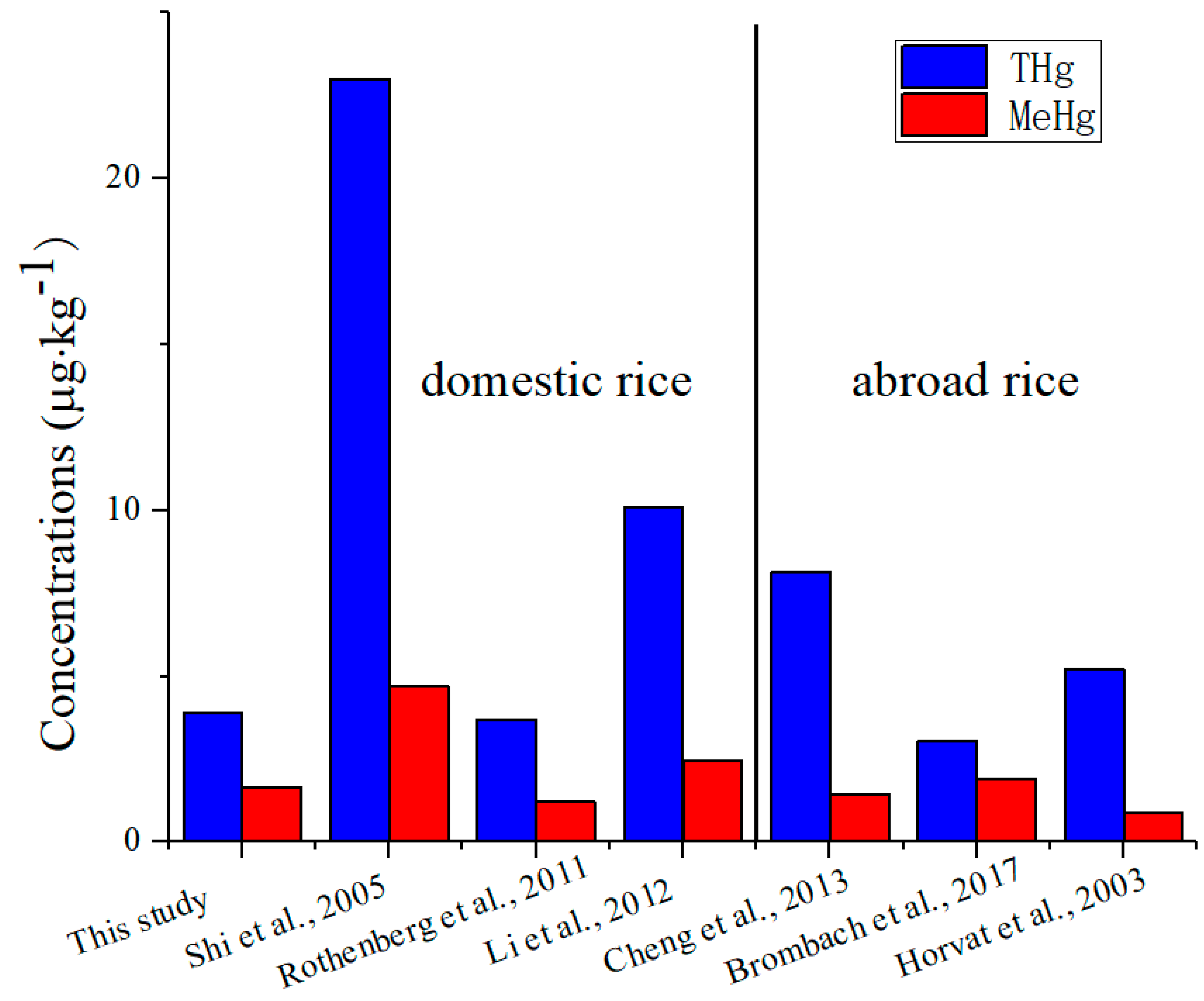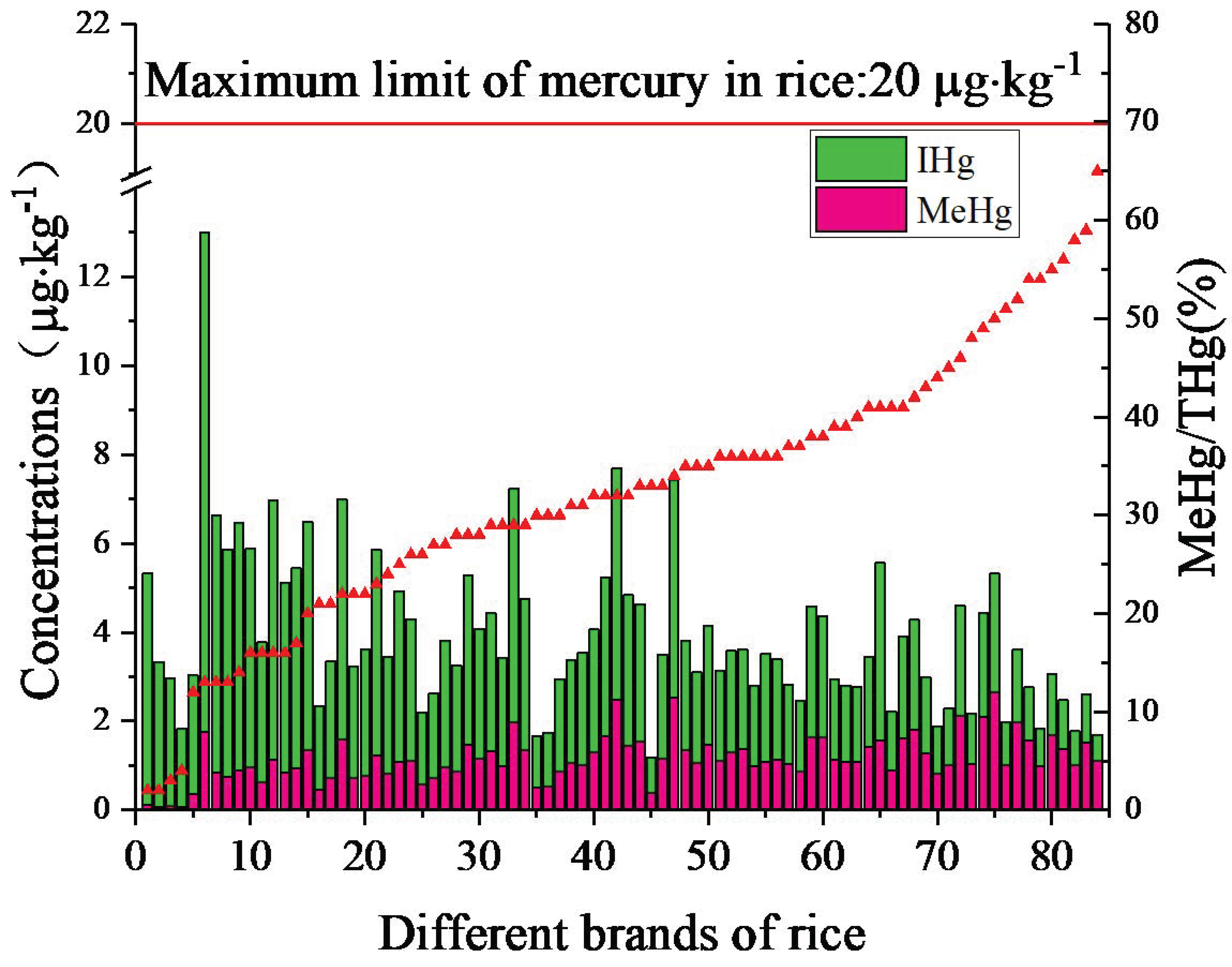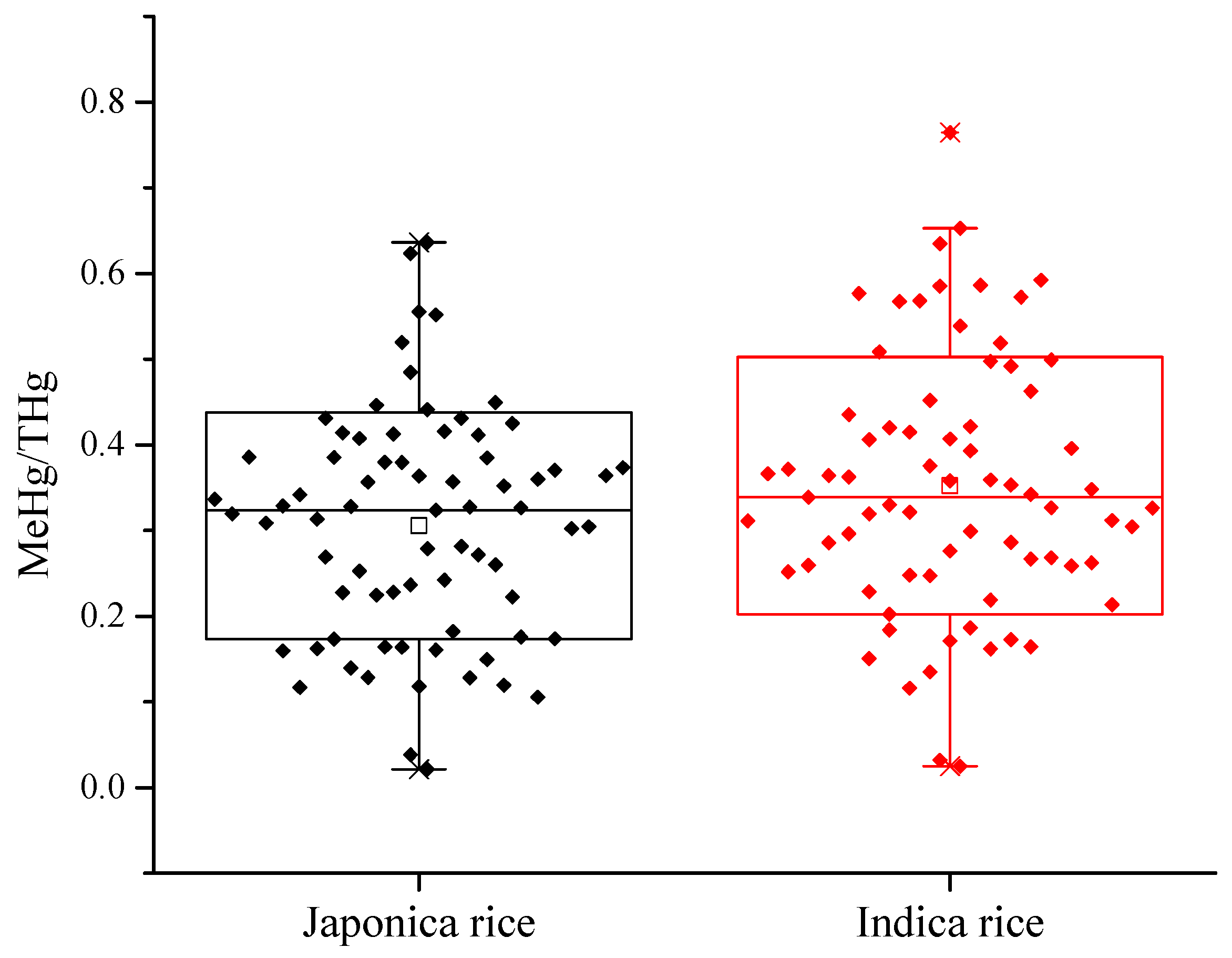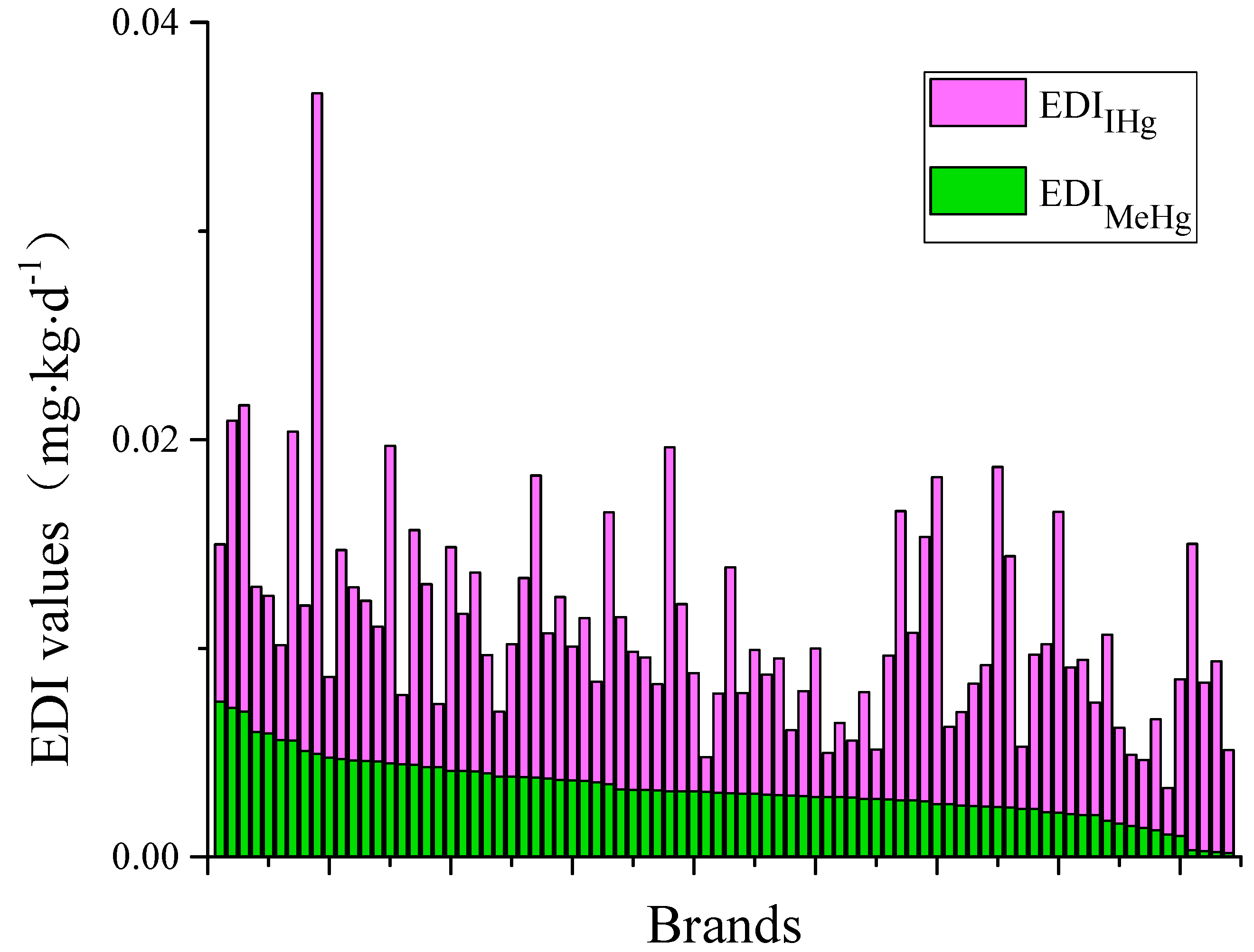Health Risk Assessment of Inorganic Mercury and Methylmercury via Rice Consumption in the Urban City of Guiyang, Southwest China
Abstract
1. Introduction
2. Methods and Materials
2.1. Study Area
2.2. Sample Collection and Preparation
2.3. Analytical Methods
2.4. Quality Assurance and Quality Control
2.5. Assessment of Human Health Risk
2.6. Statistical Analysis
3. Results and Discussion
3.1. THg and MeHg in Rice
3.1.1. Whole Market Samples
3.1.2. Variations in Brands
3.1.3. Variations in Types
3.2. Risk Assessment via Rice Consumption
4. Conclusions
Author Contributions
Funding
Acknowledgments
Conflicts of Interest
References
- Clarkson, T.W.; Magos, L. The toxicology of mercury and its chemical compounds. Crit. Rev. Toxicol. 2006, 36, 609–662. [Google Scholar] [CrossRef] [PubMed]
- Li, P.; Du, B.Y.; Chan, H.M.; Feng, X.B. Human inorganic mercury exposure, renal effects and possible pathways in Wanshan mercury mining area, China. Environ. Res. 2015, 140, 198–204. [Google Scholar] [CrossRef] [PubMed]
- Rahola, T.; Hattula, T.; Korolainen, A.; Miettinen, J.K. Elimination of free and protein-bound ionic mercury (20Hg2+) in man. Ann. Clin. Res. 1973, 5, 214–219. [Google Scholar]
- World Health Organization (WHO). Environmental Health Criteria 118: Inorganic Mercury; WHO: Geneva, Switzerland, 1991. [Google Scholar]
- Feng, X.; Li, P.; Qiu, G.L.; Wang, S.F.; Li, G.H.; Shang, L.H.; Meng, B.; Jiang, H.M.; Bai, W.Y.; Li, Z.G.; et al. Human exposure to methylmercury through rice intake in mercury mining areas, Guizhou province, China. Environ. Sci. Technol. 2008, 42, 326–332. [Google Scholar] [CrossRef] [PubMed]
- World Health Organization (WHO). Methylmercury: Environmental Health Criteria 101; WHO: Geneva, Switzerland, 1990. [Google Scholar]
- United States Environmental Protection Agency (USEPA). Mercury Study Report to the Congress, Volume V: Health Effects of Mercury and Mercury Compounds; USEPA: Washington, DC, USA, 1997.
- Clarkson, T.W. Mercury: Major issues in environmental health. Environ. Health Perspect. 1993, 100, 31–38. [Google Scholar] [CrossRef]
- Qiu, G.; Feng, X.; Li, P.; Wang, S.; Li, G.; Shang, L.; Fu, X. Methylmercury accumulation in rice (Oryza sativa L.) grown at abandoned mercury mines in Guizhou, China. J. Agric. Food Chem. 2008, 56, 2465–2468. [Google Scholar] [CrossRef] [PubMed]
- Zhang, H.; Feng, X.; Larssen, T.; Qiu, G.; Vogt, R.D. In inland China, rice, rather than fish, is the major pathway for methylmercury exposure. Environ. Health Perspect. 2010, 118, 1183–1188. [Google Scholar] [CrossRef]
- Food and Agriculture Organization of the United Nations (FAO). Rice Is Life. 2006. Available online: http://www.fao.org/newsroom/en/news/2006/1000267/index.html (accessed on 5 November 2018).
- Phuong, T.D.; Chuong, P.V.; Khiem, D.T.; Kokot, S. Elemental content of Vietnamese rice. Part 1. Sampling, analysis and comparison with previous studies. Analyst 1999, 124, 553–560. [Google Scholar] [CrossRef]
- Horvat, M.; Nolde, N.; Fajon, V.; Jereb, V.; Logar, M.; Lojen, S.; Jacimovic, R.; Falnog, I.; Qu, L.; Faganeli, J.; et al. Total mercury, methylmercury and selenium in mercury polluted areas in the province Guizhou, China. Sci. Total Environ. 2003, 304, 231–256. [Google Scholar] [CrossRef]
- Li, P.; Feng, X.; Shang, L.; Qiu, G.; Meng, B.; Zhang, H.; Guo, Y.; Liang, P. Human co-exposure to mercury vapor and methylmercury in artisanal mercury mining areas, Guizhou, China. Ecotoxicol. Environ. Saf. 2011, 74, 473–479. [Google Scholar] [CrossRef]
- Shi, J.; Liang, L.N.; Jiang, G. Simultaneous determination of methylmercury and ethylmercury in rice by capillary gas chromatography coupled on-line with atomic fluorescence spectrometry. J. AOAC Int. 2005, 88, 665–669. [Google Scholar] [PubMed]
- Qian, Y.Z.; Chen, C.; Zhang, Q.; Li, Y.; Chen, Z.J.; Li, M. Concentrations of cadmium, lead, mercury and arsenic in Chinese market milled rice and associated population health risk. Food Control 2010, 21, 1757–1763. [Google Scholar] [CrossRef]
- Li, P.; Feng, X.B.; Yuan, X.B.; Chan, H.M.; Qiu, G.L.; Sun, G.X.; Zhu, Y.G. Rice consumption contributes to low level methylmercury exposure in southern China. Environ. Int. 2012, 49, 18–23. [Google Scholar] [CrossRef] [PubMed]
- Huang, Z.; Pan, X.D.; Wu, P.G.; Han, J.L.; Chen, Q. Health risk assessment of heavy metals in rice to the population in Zhejiang, China. PLoS ONE 2013, 8, e75007. [Google Scholar] [CrossRef] [PubMed]
- Ministry of Public Health of China. GB 2762-2012 China National Food Safety Standard: Maximum Limit of Contaminants in Food. Available online: http://www.nhfpc.gov.cn/ewebeditor/uploadfile/2013/01/20130128114248937.pdf (accessed on 5 November 2018).
- United States Environmental Protection Agency (USEPA). Method 1631: Mercury in Water by Oxidation, Purge and Trap, and Cold Vapor Atomic Fluorescence Spectrometry; USEPA: Washington, DC, USA, 2002; pp. 1–33.
- United States Environmental Protection Agency (USEPA). Method 1630: MethylMercury in Water by Distillation, Aqueous Ethylation, Purge and Trap, and CVAFS; USEPA: Washington, DC, USA, 2001; pp. 1–41.
- Zheng, N.; Wang, Q.; Zhang, X.; Zheng, D.; Zhang, Z.; Zhang, S. Population health risk due to dietary intake of heavy metals in the industrial area of Huludao city, China. Sci. Total Environ. 2007, 387, 96–104. [Google Scholar] [CrossRef] [PubMed]
- MBS. Guiyang Statistical Yearbook—2017; Municipal Bureau of Statistics of Guiyang, Guiyang Statistics Press: Guiyang, China, 2017.
- Joint FAO/WHO Expert Committee on Food Additives (JECFA). The Joint FAO/WHO Food Standards Programme, Committee of the Codex Alimentarius Commission, Thirty-Third Session. Available online: http://www.fsis.usda.gov/PDF/2010-CAC/cac33_15e.pdf (accessed on 20 July 2010).
- Xu, X.; Meng, B.; Zhang, C.; Feng, X.; Gu, C.; Guo, J.; Bishop, K.; Xu, Z.; Zhang, S.; Qiu, G. The local impact of a coal-fired power plant on inorganic mercury and methyl-mercury distribution in rice (Oryza sativa L.). Environ. Pollut. 2017, 223, 11–18. [Google Scholar] [CrossRef] [PubMed]
- Cheng, J.; Gao, L.; Zhao, W.; Liu, X.; Sakamoto, M.; Wang, W. Mercury levels in fisherman and their household members in Zhoushan, China: Impact of public health. Sci. Total Environ. 2009, 407, 2625–2630. [Google Scholar] [CrossRef] [PubMed]
- Cao, H.; Chen, J.; Zhang, J.; Hui, Z.; Li, Q.; Yi, M. Heavy metals in rice and garden vegetables and their potential health risks to inhabitants in the vicinity of an industrial zone in Jiangsu, China. J. Environ. Sci. 2010, 22, 1792–1799. [Google Scholar] [CrossRef]
- Meng, B.; Feng, X.; Qiu, G.; Cai, Y.; Wang, D.; Li, P.; Shang, L.; Sommar, J. Distribution Patterns of Inorganic Mercury and Methylmercury in Tissues of Rice (Oryza sativa L.) Plants and Possible Bioaccumulation Pathways. J. Agric. Food Chem. 2010, 58, 4951–4958. [Google Scholar] [CrossRef]
- Batista, B.L.; Nacano, L.R.; Freitas, R.D.; Oliveira-Souza, V.C.D.; Barbosa, F. Determination of Essential (Ca, Fe, I, K, Mo) and Toxic Elements (Hg, Pb) in Brazilian Rice Grains and Estimation of Reference Daily Intake. Food Nutr. Sci. 2012, 3, 129–134. [Google Scholar] [CrossRef]
- Cheng, Z.; Wang, H.S.; Du, J.; Sthiannopkao, S.; Xing, G.H.; Kim, K.W.; Yasin, M.S.M.; Hashim, J.H.; Wong, M.H. Dietary exposure and risk assessment of mercury via total diet study in Cambodia. Chemosphere 2013, 92, 143–149. [Google Scholar] [CrossRef] [PubMed]
- Brombach, C.C.; Manorut, P.; Kolambage-Dona, P.P.P.; Ezzeldin, M.F.; Chen, B.; Corns, W.T.; Feldmann, J.; Krupp, E.M. Methylmercury varies more than one order of magnitude in commercial European rice. Food Chem. 2017, 214, 360–365. [Google Scholar] [CrossRef] [PubMed]
- Rothenberg, S.E.; Feng, X.; Dong, B.; Shang, L.; Yin, R.; Yuan, X. Characterization of mercury species in brown and white rice (Oryza sativa L.) grown in water-saving paddies. Environ. Pollut. 2011, 159, 1283–1289. [Google Scholar] [CrossRef]
- Rothenberg, S.E.; Feng, X.; Zhou, W.; Tu, M.; Jin, B.; You, J. Environment and genotype controls on mercury accumulation in rice (Oryza sativa L.) cultivated along a contamination gradient in Guizhou, China. Sci. Total Environ. 2012, 426, 272–280. [Google Scholar] [CrossRef] [PubMed]
- Peng, X.; Liu, F.; Wang, W.X.; Ye, Z. Reducing total mercury and methylmercury accumulation in rice grains through water management and deliberate selection of rice cultivars. Environ. Pollut. 2012, 162, 202–208. [Google Scholar] [CrossRef] [PubMed]
- Li, P.; Feng, X.B.; Qiu, G.L.; Shang, L.H.; Wang, S.F. Mercury exposure in the population from Wuchuan mercury mining area, Guizhou, China. Sci. Total Environ. 2008, 395, 72–79. [Google Scholar] [CrossRef] [PubMed]




| Types | THg (μg·kg−1) | MeHg (μg·kg−1) | MeHg/THg (%) | IHg (μg·kg−1) | EDIMeHg (μg·kg−1·d−1) | HQMeHg | EDIIHg (μg·kg−1·d−1) | HQIHg | THQ |
|---|---|---|---|---|---|---|---|---|---|
| Japonica rice (n = 73) | 3.96 (1.71–13.10) | 1.10 (0.07–2.68) | 31 (2–64) | 2.86 (0.96–11.56) | 0.0031 (0.0002–0.0076) | 0.0311 (0.0020–0.0756) | 0.0080 (0.0027–0.0326) | 0.0141 (0.0047–0.0570) | 0.0452 (0.0106–0.1004) |
| Indica rice (n = 73) | 3.80 (0.97–13.00) | 1.22 (0.08–2.66) | 35 (2–76) | 2.57 (0.42–11.25) | 0.0034 (0.0002–0.0075) | 0.0345 (0.0023–0.0750) | 0.0073 (0.0012–0.0317) | 0.0127 (0.0021–0.0554) | 0.0472 (0.0147–0.1048) |
| Brands | THg (μg·kg−1) | MeHg (μg·kg−1) | MeHg/THg (%) | IHg (μg·kg−1) | HQMeHg | HQIHg | THQ |
|---|---|---|---|---|---|---|---|
| AMN (n = 1) | 2.47 ± 0.02 | 1.37 ± 0.22 | 56% | 1.10 | 0.0386 | 0.0054 | 0.0440 |
| BDH (n = 2) | 5.22 ± 0.70 | 1.67 ± 0.17 | 32% | 3.55 | 0.0469 | 0.0175 | 0.0644 |
| BF (n = 1) | 1.70 ± 0.28 | 1.11 ± 0.08 | 65% | 0.59 | 0.0312 | 0.0029 | 0.0341 |
| BFYR (n = 1) | 2.28 ± 0.05 | 1.02 ± 0.05 | 45% | 1.26 | 0.0287 | 0.0062 | 0.0349 |
| BNM (n = 1) | 3.91 ± 0.13 | 1.62 ± 0.14 | 41% | 2.29 | 0.0456 | 0.0113 | 0.0570 |
| BWG (n = 1) | 6.97 ± 0.14 | 1.12 ± 0.17 | 16% | 5.85 | 0.0315 | 0.0289 | 0.0604 |
| CSH (n = 3) | 3.40 ± 0.46 | 1.14 ± 0.63 | 36% | 2.26 | 0.0321 | 0.0111 | 0.0433 |
| CW (n = 1) | 3.49 ± 0.09 | 1.14 ± 0.18 | 33% | 2.35 | 0.0322 | 0.0116 | 0.0438 |
| CZB (n = 1) | 2.82 ± 0.11 | 1.03 ± 0.12 | 37% | 1.79 | 0.0291 | 0.0088 | 0.0379 |
| DBDM (n = 1) | 2.63 ± 0.09 | 0.71 ± 0.09 | 27% | 1.91 | 0.0201 | 0.0094 | 0.0295 |
| DJX (n = 1) | 1.87 ± 0.18 | 0.82 ± 0.05 | 44% | 1.06 | 0.0230 | 0.0052 | 0.0282 |
| FLM (n = 10) | 2.78 ± 0.57 | 1.09 ± 0.30 | 40% | 1.69 | 0.0308 | 0.0083 | 0.0391 |
| FX (n = 1) | 3.33 ± 0.03 | 0.083 ± 0.005 | 2% | 3.25 | 0.0023 | 0.0160 | 0.0184 |
| GF (n = 1) | 4.64 ± 0.12 | 1.53 ± 0.07 | 33% | 3.11 | 0.0431 | 0.0153 | 0.0585 |
| GFXR (n = 1) | 3.44 ± 0.04 | 1.43 ± 0.08 | 41% | 2.01 | 0.0402 | 0.0099 | 0.0501 |
| GTX (n = 1) | 3.38 ± 0.11 | 1.05 ± 0.09 | 31% | 2.33 | 0.0297 | 0.0115 | 0.0412 |
| HBDM (n = 1) | 5.32 ± 0.14 | 2.64 ± 0.11 | 50% | 2.67 | 0.0745 | 0.0132 | 0.0877 |
| HBRD (n = 1) | 13.00 ± 2.38 | 1.75 ± 0.07 | 13% | 11.25 | 0.0494 | 0.0554 | 0.1048 |
| HBRX (n = 1) | 7.42 ± 0.19 | 2.54 ± 0.10 | 34% | 4.88 | 0.0714 | 0.0241 | 0.0955 |
| HDXA (n = 3) | 4.84 ± 1.22 | 1.46 ± 0.40 | 32% | 3.38 | 0.0410 | 0.0167 | 0.0577 |
| HF (n = 1) | 3.13 ± 0.02 | 1.12 ± 0.18 | 36% | 2.01 | 0.0314 | 0.0099 | 0.0413 |
| HJDC (n = 1) | 7.00 ± 0.07 | 1.60 ± 0.10 | 23% | 5.40 | 0.0449 | 0.0266 | 0.0716 |
| HJDY (n = 1) | 4.08 ± 0.04 | 1.15 ± 0.07 | 28% | 2.93 | 0.0324 | 0.0145 | 0.0469 |
| HL (n = 2) | 2.76 ± 2.53 | 1.57 ± 1.54 | 54% | 1.19 | 0.0443 | 0.0058 | 0.0502 |
| HLX (n = 2) | 3.81 ± 1.09 | 0.96 ± 0.24 | 27% | 2.85 | 0.0271 | 0.0140 | 0.0412 |
| HY (n = 2) | 3.26 ± 1.13 | 0.86 ± 0.07 | 28% | 2.40 | 0.0242 | 0.0118 | 0.0360 |
| HZH (n = 3) | 2.46 ± 0.43 | 0.87 ± 0.28 | 37% | 1.59 | 0.0246 | 0.0078 | 0.0324 |
| JCYP (n = 1) | 4.36 ± 0.05 | 1.64 ± 0.09 | 38% | 2.72 | 0.0461 | 0.0134 | 0.0595 |
| JJ-1 (n = 4) | 3.10 ± 0.80 | 1.06 ± 0.08 | 35% | 2.04 | 0.0297 | 0.0101 | 0.0398 |
| JJ-2 (n = 2) | 4.42 ± 0.55 | 1.31 ± 0.61 | 29% | 3.11 | 0.0370 | 0.0153 | 0.0523 |
| JLY (n = 9) | 3.54 ± 1.70 | 1.02 ± 0.47 | 31% | 2.52 | 0.0288 | 0.0124 | 0.0412 |
| JX (n = 2) | 4.44 ± 1.06 | 2.10 ± 0.01 | 49% | 2.34 | 0.0593 | 0.0115 | 0.0708 |
| JYB (n = 3) | 3.60 ± 0.84 | 1.99 ± 1.02 | 52% | 1.62 | 0.0559 | 0.0080 | 0.0639 |
| KK (n = 2) | 5.27 ± 0.76 | 1.47 ± 0.01 | 28% | 3.80 | 0.0413 | 0.0188 | 0.0601 |
| KS (n = 1) | 4.30 ± 0.11 | 1.12 ± 0.10 | 26% | 3.18 | 0.0315 | 0.0157 | 0.0472 |
| LDT (n = 1) | 3.58 ± 0.03 | 1.30 ± 0.11 | 36% | 2.28 | 0.0367 | 0.0112 | 0.0480 |
| LF (n = 1) | 3.36 ± 0.13 | 0.72 ± 0.08 | 21% | 2.64 | 0.0202 | 0.0130 | 0.0332 |
| LFHT (n = 1) | 2.94 ± 0.06 | 1.13 ± 0.18 | 39% | 1.81 | 0.0319 | 0.0089 | 0.0408 |
| LFY (n = 3) | 5.86 ± 2.16 | 1.24 ± 0.14 | 23% | 4.63 | 0.0348 | 0.0228 | 0.0576 |
| LH (n = 1) | 3.02 ± 0.10 | 0.36 ± 0.04 | 12% | 2.66 | 0.0102 | 0.0131 | 0.0233 |
| LY (n = 2) | 6.49 ± 1.56 | 1.36 ± 0.68 | 20% | 5.14 | 0.0382 | 0.0253 | 0.0635 |
| LZ (n = 2) | 4.59 ± 1.23 | 1.64 ± 0.41 | 38% | 2.95 | 0.0462 | 0.0145 | 0.0607 |
| MG (n = 3) | 3.62 ± 0.77 | 1.37 ± 0.62 | 36% | 2.25 | 0.0386 | 0.0111 | 0.0497 |
| MNX (n = 1) | 1.17 ± 0.29 | 0.38 ± 0.02 | 33% | 0.79 | 0.0108 | 0.0039 | 0.0147 |
| MPS (n = 2) | 4.93 ± 2.17 | 1.08 ± 0.03 | 25% | 3.84 | 0.0306 | 0.0190 | 0.0495 |
| MSJL (n = 1) | 5.12 ± 0.20 | 0.84 ± 0.10 | 16% | 4.28 | 0.0237 | 0.0211 | 0.0448 |
| MX (n = 1) | 2.97 ± 0.03 | 0.09 ± 0.01 | 3% | 2.87 | 0.0027 | 0.0142 | 0.0168 |
| MYG (n = 1) | 4.28 ± 0.04 | 1.80 ± 0.10 | 42% | 2.48 | 0.0508 | 0.0122 | 0.0630 |
| NJM (n = 2) | 3.23 ± 0.16 | 0.73 ± 0.28 | 22% | 2.50 | 0.0205 | 0.0123 | 0.0328 |
| PBZY (n = 1) | 1.65 ± 0.09 | 0.49 ± 0.03 | 30% | 1.16 | 0.0139 | 0.0057 | 0.0196 |
| QFDY (n = 1) | 3.45 ± 0.07 | 0.81 ± 0.13 | 24% | 2.63 | 0.0229 | 0.0130 | 0.0359 |
| QH (n = 2) | 2.34 ± 0.53 | 0.46 ± 0.20 | 21% | 1.88 | 0.0129 | 0.0093 | 0.0222 |
| QL (n = 1) | 5.87 ± 0.06 | 0.75 ± 0.05 | 13% | 5.12 | 0.0212 | 0.0252 | 0.0464 |
| QLC (n = 1) | 5.32 ± 0.06 | 0.11 ± 0.01 | 2% | 5.21 | 0.0031 | 0.0257 | 0.0288 |
| QSC (n = 1) | 4.07 ± 0.74 | 1.30 ± 0.05 | 32% | 2.77 | 0.0366 | 0.0136 | 0.0502 |
| SDX (n = 1) | 1.98 ± 0.12 | 1.01 ± 0.06 | 51% | 0.97 | 0.0284 | 0.0048 | 0.0332 |
| SN (n = 1) | 5.88 ± 0.12 | 0.96 ± 0.15 | 16% | 4.92 | 0.0272 | 0.0243 | 0.0514 |
| SXY (n = 1) | 4.14 ± 0.11 | 1.46 ± 0.07 | 35% | 2.68 | 0.0412 | 0.0132 | 0.0543 |
| SY (n = 5) | 5.56 ± 4.43 | 1.57 ± 0.28 | 41% | 3.99 | 0.0442 | 0.0197 | 0.0639 |
| TF (n = 2) | 7.24 ± 3.07 | 1.98 ± 0.23 | 29% | 5.25 | 0.0559 | 0.0259 | 0.0818 |
| TGXM (n = 1) | 7.69 ± 0.20 | 2.47 ± 0.11 | 32% | 5.22 | 0.0696 | 0.0257 | 0.0953 |
| TH (n = 1) | 2.21 ± 0.07 | 0.90 ± 0.08 | 41% | 1.31 | 0.0253 | 0.0065 | 0.0318 |
| TQ (n = 1) | 3.06 ± 0.08 | 1.69 ± 0.08 | 55% | 1.37 | 0.0476 | 0.0068 | 0.0543 |
| TXA (n = 1) | 1.77 ± 0.10 | 1.02 ± 0.05 | 58% | 0.75 | 0.0287 | 0.0037 | 0.0324 |
| TXX (n = 1) | 6.46 ± 0.06 | 0.90 ± 0.06 | 14% | 5.56 | 0.0254 | 0.0274 | 0.0528 |
| WC (n = 2) | 5.44 ± 0.63 | 0.95 ± 0.21 | 17% | 4.50 | 0.0267 | 0.0222 | 0.0488 |
| WF (n = 4) | 3.62 ± 1.08 | 0.76 ± 0.45 | 22% | 2.86 | 0.0214 | 0.0141 | 0.0355 |
| WH (n = 4) | 2.95 ± 0.47 | 0.87 ± 0.15 | 30% | 2.08 | 0.0245 | 0.0102 | 0.0347 |
| WMCX (n = 1) | 3.78 ± 0.13 | 0.61 ± 0.07 | 16% | 3.17 | 0.0173 | 0.0156 | 0.0329 |
| WPW (n = 1) | 1.83 ± 0.30 | 0.99 ± 0.07 | 54% | 0.84 | 0.0278 | 0.0042 | 0.0320 |
| XBB (n = 1) | 2.98 ± 0.07 | 1.27 ± 0.11 | 43% | 1.72 | 0.0357 | 0.0085 | 0.0442 |
| XGYJ (n = 1) | 2.60 ± 0.08 | 1.53 ± 0.11 | 59% | 1.08 | 0.0430 | 0.0053 | 0.0483 |
| XL (n = 1) | 6.63 ± 0.06 | 0.85 ± 0.05 | 13% | 5.78 | 0.0240 | 0.0285 | 0.0525 |
| XMY (n = 4) | 2.80 ± 0.35 | 0.99 ± 0.09 | 36% | 1.82 | 0.0278 | 0.0090 | 0.0368 |
| XNL (n = 1) | 1.74 ± 0.43 | 0.53 ± 0.03 | 30% | 1.21 | 0.0149 | 0.0060 | 0.0209 |
| XRJ (n = 4) | 3.52 ± 1.89 | 1.08 ± 0.44 | 36% | 2.45 | 0.0303 | 0.0121 | 0.0423 |
| XXBX (n = 1) | 2.20 ± 0.22 | 0.57 ± 0.03 | 26% | 1.63 | 0.0160 | 0.0080 | 0.0240 |
| XZXM (n = 1) | 3.43 ± 0.11 | 0.98 ± 0.08 | 29% | 2.45 | 0.0276 | 0.0121 | 0.0397 |
| YCL (n = 1) | 4.59 ± 0.18 | 2.12 ± 0.11 | 46% | 2.47 | 0.0598 | 0.0122 | 0.0720 |
| YD (n = 1) | 3.80 ± 0.08 | 1.34 ± 0.21 | 35% | 2.46 | 0.0377 | 0.0121 | 0.0498 |
| YYP (n = 1) | 1.82 ± 0.07 | 0.07 ± 0.01 | 4% | 1.75 | 0.0020 | 0.0086 | 0.0106 |
| YZXM (n = 1) | 4.74 ± 0.12 | 1.36 ± 0.06 | 29% | 3.39 | 0.0382 | 0.0167 | 0.0549 |
| YZZ (n = 1) | 2.16 ± 0.02 | 1.05 ± 0.17 | 48% | 1.11 | 0.0295 | 0.0055 | 0.0349 |
| ZJB (n =1) | 2.79 ± 0.07 | 1.08 ± 0.05 | 39% | 1.71 | 0.0303 | 0.0085 | 0.0388 |
© 2019 by the authors. Licensee MDPI, Basel, Switzerland. This article is an open access article distributed under the terms and conditions of the Creative Commons Attribution (CC BY) license (http://creativecommons.org/licenses/by/4.0/).
Share and Cite
Han, J.; Chen, Z.; Pang, J.; Liang, L.; Fan, X.; Li, Q. Health Risk Assessment of Inorganic Mercury and Methylmercury via Rice Consumption in the Urban City of Guiyang, Southwest China. Int. J. Environ. Res. Public Health 2019, 16, 216. https://doi.org/10.3390/ijerph16020216
Han J, Chen Z, Pang J, Liang L, Fan X, Li Q. Health Risk Assessment of Inorganic Mercury and Methylmercury via Rice Consumption in the Urban City of Guiyang, Southwest China. International Journal of Environmental Research and Public Health. 2019; 16(2):216. https://doi.org/10.3390/ijerph16020216
Chicago/Turabian StyleHan, Jialiang, Zhuo Chen, Jian Pang, Longchao Liang, Xuelu Fan, and Qiuhua Li. 2019. "Health Risk Assessment of Inorganic Mercury and Methylmercury via Rice Consumption in the Urban City of Guiyang, Southwest China" International Journal of Environmental Research and Public Health 16, no. 2: 216. https://doi.org/10.3390/ijerph16020216
APA StyleHan, J., Chen, Z., Pang, J., Liang, L., Fan, X., & Li, Q. (2019). Health Risk Assessment of Inorganic Mercury and Methylmercury via Rice Consumption in the Urban City of Guiyang, Southwest China. International Journal of Environmental Research and Public Health, 16(2), 216. https://doi.org/10.3390/ijerph16020216




